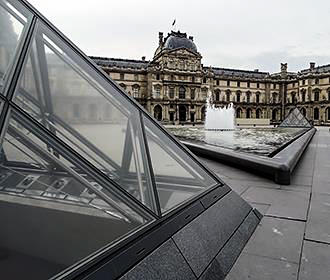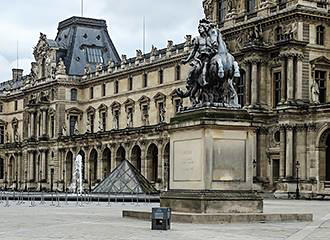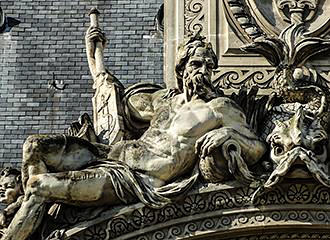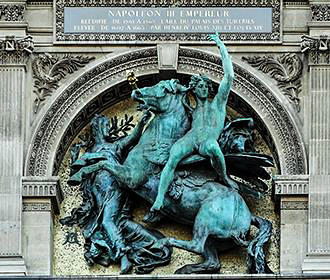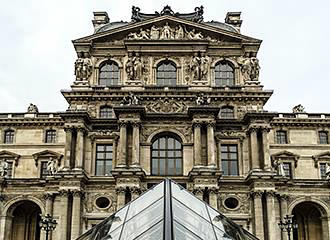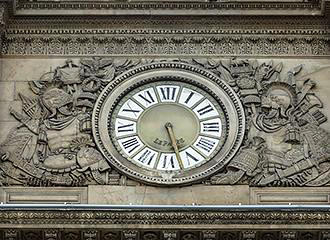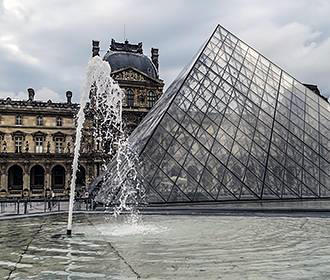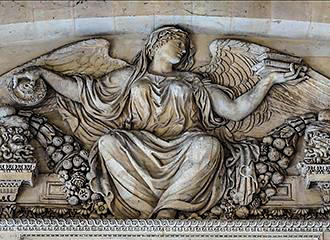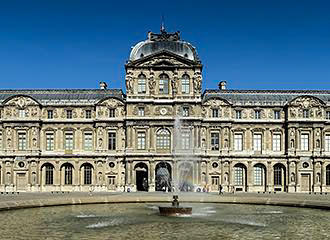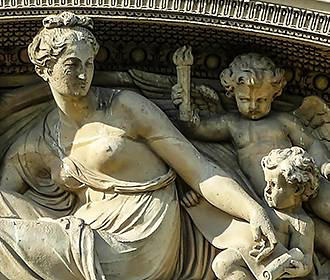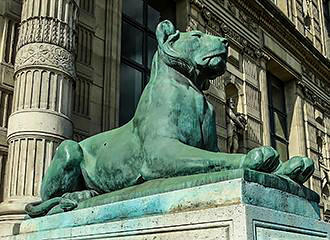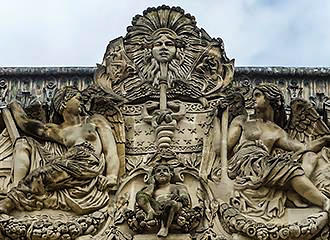The Louvre History from Fortress to Palace to Museum
Originally the Louvre was a fortress, then it was turned into a Royal Palace and then it became a museum, and today, the Musee du Louvre is the most famous of all Paris museums and it is the most visited museum in the world.
The Louvre history beginnings
It all started in the Middle Ages near the end of the 12th century during the reign of King Philippe Auguste that the French monarchy were growing in their power quite dramatically, and at that time, Paris was the largest city in Europe.
Because of this, it was decided that a fortress needed to be constructed to protect the city and the monarchy, with construction of the fortress and keep beginning in 1190 on a strategic position at the West side of Paris along the River Seine.
Named the Louvre, it was not designed as a royal residence, as it was built to be an arsenal that had defensive towers, which flanked narrow gates, a moat, along with having round bastions at the corners. In the centre of the fortress was an exceedingly large keep called the Grosse Tour, which stood around 15m across and 30m high.
By the middle of the 14th century the capital city of Paris had expended well beyond the original walls of the Louvre fortress and therefore new defences were deemed necessary, especially with the onset of the Hundred Year War, and therefore this original fortress lost its purpose.
The Louvre history transformation into a Royal Palace
King Charles V decided that since the Louvre fortress was no longer needed to defend the city, it should be turned into a royal palace and the task of transforming the building was down to Raymond du Temple, the chief architect for King Charles V.
So in 1364, Raymond du Temple started changing the Louvre with elaborately carved windows and a beautiful spiral staircase called the Grande Vis, which was to access the upper floors of the new buildings.
The whole building was decorated elaborately with lavish furnishings and had wood panelling, tapestries, paintings and sculptures to add to the sumptuous Louvre Palace, plus there was a pleasure garden added at the north end of the Louvre.
However, after the death of King Charles VI, the Louvre palace started to go into disrepair. That is, until King Francois I decided he wanted to live in Paris and so, in 1527 the Grosse Tour, which was the original keep in the middle, was destroyed to allow more light and space into the palace.
But King Francois I was not satisfied with the size of the chateau that King Charles had utilised and therefore he ordered the construction of new buildings in 1546. The medieval west wing of the castle was destroyed to be replaced with the Renaissance styled buildings designed by the architect Pierre Lescot and decorated by Jean Goujon who was a sculptor.
In fact, some of the sculptors most famous works can still be seen around Paris today, like those on the facade of the Cour Carree at The Louvre museum, and the Fontaine des Innocents, which is a fountain located in the Place Joachim-du-Bellay, although the reliefs are now held within the Paris Musee du Louvre and have been replaced by copies.
Even though it was originally King Francois I who instigated these changes to take place, the Louvre history shows the transformation of the Louvre into a Renaissance Palace continued through the reign of King Henri II who had the Salle des Caryatides constructed, and this hall takes its name from the four female figures that were sculpted by Jean Goujon to support the musicians gallery.
The medieval south wing of the castle was destroyed and a new wing constructed along with the Pavillon du Roi, or Kings Pavilion, which was to house the kings apartments on the first floor. However these works continued through the reign of King Henri II and by his sons and the decoration of these was not finished until the reign of King Henri IV.
Yet unfortunately, the only part of the original medieval building that remains is the lower hall called the Salle Basse, which dates from around 1230, and you can still get to see the two columns that supported a vaulted ceiling, although the ceiling itself was destroyed.
The Louvre history and the Tuileries Palace
King Henri II, unfortunately never got to see any of this work completed and when he died after being fatally wounded during a jousting tournament, his wife, Catherine de Medicis, did not wish to stay at the chateau on the Place des Vosges and wanted to move to the Louvre palace.
But she was also not happy with the discomfort and the lack of refinements at the Louvre, so Catherine de Medicis ordered the building of a new palace a short distance away. So plans were drawn up in 1564 for the building of the Tuileries Palace and gardens, which were designed by the French architect Philibert Delorme, who was a Renaissance master.
Work began under the reign of King Charles IX in 1566 to build the Petite Galerie that was designed as a small wing, which would connect the Louvre to the Tuileries via a long building alongside the River Seine.
But the construction work was halted a few years later around the year 1572, yet the Louvre history does not stop there, as King Henri IV started more construction work to continue the original plans to connect the Tuileries Palace and the Louvre palace together along the River Seine.
The next phase in the construction came with the Galerie du Bord de l’Eau, which translates to waterside gallery and this was started in 1595 and is also known as the Grande Galerie, which is a long passage that provided a link from the royal apartments at the Louvre and the Tuileries palace.
Ending at the Pavillon de Flore, the length was an impressive 450 metres, but to stop the monotony from one end of the gallery to the other, there were actually two architects hired, Louis Metezeau and Jacques II Androuet du Cerceau, who would start the work at opposite ends.
At the same time as this building work was taking place, the Galerie des Rois, or Kings Gallery, was also being constructed on the top of the Petite Galerie, however, unfortunately King Henri IV was assassinated in 1610, and neither of these projects was completed by the time of his tragic death.
Even though the buildings were in place by this time and the Grande Galerie did have a roof, there was no internal decoration, and because the successor to King Henri IV was only nine at the time of his reign, King Louis XIII was not able to continue the work straight away. It was only in 1625, when King Louis XIII was able to rule himself that the project started again.
In 1639 between the new building and the old one, there was a clock pavilion installed called the Pavillon de l’Horloge that had steeply pitched roofs and dominated the Louvre complex, but this is now known as the Pavillon Sully.
A few years later, between the years 1655 and 1658, Queen Anne of Austria who was originally married to King Louis XIII and was the mother and initially regent to King Louis XIV, decided to have a suite of private apartments created on the ground floor of the Petite Galerie.
There were a total of six interconnecting rooms including a salon, a bedroom, and a study come private sitting room, plus three others, with one of these overlooking the River Seine. The internal decoration of the frescoes and the ceilings was carried out by an Italian painter called Giovani Romanelli, with the stucco carried out by the sculptor Michel Anguier.
Then in 1660, the chief architect to King Louis XIV, who was called Louis Le Vau, was appointed in charge of overseeing the full completion of the Louvre Palace. So work started in 1661 on a new facade for the Petite Galerie, the completion of the north wing of the Cour Carree. Plus there were two new pavilions, one which was symmetrical to the Renaissance Pavillon du Roi at the eastern end and the other located in the centre.
However, Louis Le Vau also had to oversee the reconstruction work on the upper section of the Petite Galerie, as a fire had broken out in the February of 1661 and dramatically damaged this area.
It was the chief painter for King Louis XIV, called Charles le Brun, who was instructed to carry out the work on the internal decoration, and the whole design was to express the passage of the sun through the Roman God Apollo.
This is why it was called the Galerie d’Apollon, however the internal decoration was never completed although there are stucco sculptures and three ceiling panels by Charles le Brun.
In fact, both Louis Le Vau and Charles le Brun also worked on the Chateau Versailles castle, which was also under construction at this time, as it was being turned from a hunting lodge into a fabulous French chateau.
Anyway, getting back to The Louvre history, in 1665 King Louis XIV commissioned architect and sculptor Gian Lorenzo Bernini to work on the eastern wing of the Cour Carree, which was the site that was to be the new entrance to the royal palace.
But then King Louis XIV called a halt to the construction, yet in 1667 a committee had designed the Colonnade with a monumental facade with a peristyle of double columns, but again construction of this was also halted.
It was because of the progress of Chateau Versailles Castle, King Louis XIV decided to leave Paris and The Louvre, so that he could live at the castle on the outskirts of Paris, and the finance minister Jean-Baptist Colbert called a complete halt to all construction work on the Louvre.
When the Chateau de Versailles was finished, even the court and government moved to the Versailles Castle in 1682, so even though there was no roof on the Cour Carree, no more construction work at The Louvre was to take place for almost another century.
The Louvre history later years
It was the year 1756, when King Louis XV ordered the construction work to resume again on The Louvre and the north, east and south sides of the Cour Carree eventually had a roof at last.
Then, in 1791 it was decided that The Louvre and The Tuileries would be the national palace for the king, but was also to house the treasures and monuments of the arts, and so, in 1793, the Paris Musee du Louvre was born. However, the Louvre history regarding the Musee du Louvre Museum in Paris, is yet another story!
But when we look at the building itself, during the reign of Napoleon Bonaparte I, the Louvre history shows that the Tuileries were expanded and lavishly improved, such as the monumental staircase for the Salon Carre and the Grande Galerie, also with new windows that provided more light.
There was a new north wing that was progressing from the Tuileries towards the Louvre along the Rue de Rivoli and there was an arch, called the Arc de Triomphe du Carrousel constructed, which was inaugurated in 1808 and this was aligned with the Pavillon de l’Horloge and the central pavilion of the Tuileries.
However, it was not until the 1850s under the reign of Napoleon III that the north wing was finished and buildings were completed along the Rue de Rivoli, which had originally been started by Napoleon I.
There were also two new wings built with inner courtyards, along with the Cour Napoleon at the heart of this, and these were completed in 1861. Napoleon III also commissioned the Orangerie and the Jeu de Paume, which is a building designed for a real tennis game, and these were installed within the Tuileries Gardens that were designed by Andre Le Notre back in the 1600s.
It was then in 1861 the Grande Galerie and the Pavillon de Flore were rebuilt, however, unfortunately, during the Paris Commune in 1871, the Tuileries Palace was set on fire and destroyed, but thankfully the Louvre was not really affected, yet after many discussions this eventually led to the demolition and complete removal of the Tuileries Palace in 1883.
But in between these times, the Marsan and Flore Pavillons were restored and the width of the north wing along the Rue de Rivoli doubled in size, and so, that is how the majority of the Paris Musee du Louvre Museum looks today, apart from a few additional alterations, such as adding glass roofs to some inner courtyards and the addition of the famous I M Pei pyramid in the Cour Napoleon.
